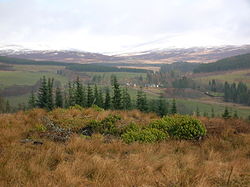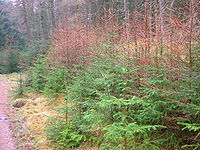
Kindrogan House
Encyclopedia

Blairgowrie and Rattray
Blairgowrie and Rattray and Raitear is possibly from an English language cognate of Gaelic ràth, meaning fortress + a Pictish term cognate with Welsh tref, meaning settlement) is a twin burgh in Perth and Kinross, Scotland. Amongst locals, the town is colloquially known simply as "Blair"...
, Perth and Kinross in Moulin parish, at the head of Strath Ardle, 7 miles (11 km) ENE of Pitlochry
Pitlochry
Pitlochry , is a burgh in the council area of Perth and Kinross, Scotland, lying on the River Tummel. Its population according to the 2001 census was 2,564....
and 2½ miles (4 km) northwest of Kirkmichael. It is run by the Field Studies Council
Field Studies Council
The Field Studies Council is an educational charity based in the UK. It opened its first Field Centre in 1947 at Flatford Mill, and now operates 17 Field Centres in various locations in England, Wales, Northern Ireland and Scotland offering both residential and non-residential field courses...
.
Kindrogan House and Field Studies Centre


Quoin (architecture)
Quoins are the cornerstones of brick or stone walls. Quoins may be either structural or decorative. Architects and builders use quoins to give the impression of strength and firmness to the outline of a building...
s.
The centre lies below Kindrogan Hill (185 m) off the A294 Pitlochry to Braemar road and the nearest railway station
Pitlochry railway station
Pitlochry railway station serves the town of Pitlochry in Perth and Kinross, Scotland. It is served by First ScotRail trains between Glasgow or Edinburgh and Inverness, and the daily East Coast service between London and Inverness....
is at Pitlochry. The extensive Kindrogan Woods, mostly coniferous, cover the lower slopes of the hill and the River Ardle
River Ardle
The River Ardle is a tributary of the River Ericht. It runs for through the valley of Strathardle in Perthshire, Scotland. It is a salmon river providing opportunities for angling.-Course:...
forms a boundary to the east of the house. An old curling pond lies beside the driveway to the West Lodge.
Centre facilities
A well stocked natural and local history library is located in Kindrogan House, open at all times. Tea and coffee facilities are located near the reception lounge and in the upstairs lounge, adjoining which is a licensed bar. A shop opens each day to sell maps, stationary, confectionary, postcards, stamps, etc. A large drying room is provided to hang wet clothes, waterproofs, boots, etc. Mobile phones do not all have good reception, however phone boxes are provided. The Ardle wing at the back of the building has single room accommodation and elsewhere bunkbeds and twin rooms are provided.History of the Kindrogan estate


In the 1880s Patrick Small Keir, Esq. (b. 1810), held the 10000 acres (40.5 km²) estate, valued at £2445 per annum.
A plaque beside the path running from the house to the Enochdu Lodge beside the River Ardle records that Queen Victoria once stopped here for tea on an excursion from Dunkeld
Dunkeld
Dunkeld is a small town in Strathtay, Perth and Kinross, Scotland. It is about 15 miles north of Perth on the eastern side of the A9 road into the Scottish Highlands and on the opposite side of the Tay from the Victorian village of Birnam. Dunkeld and Birnam share a railway station, on the...
to Spittal of Glenshee.
Another eminent visitor was Lord Cockburn, a circuit judge, and frequent guest of the Keirs.
A number of fine trees and avenues survive from in the old estate policies, including several fine Wellintonia
Sequoiadendron
Sequoiadendron giganteum is the sole living species in the genus Sequoiadendron, and one of three species of coniferous trees known as redwoods, classified in the family Cupressaceae in the subfamily Sequoioideae, together with Sequoia sempervirens and...
s, oaks, limes lining the main drives, yews and specimen sycamores beside the River Ardle. Red squirrels are still common (2009) and the river has many hazels, birches and alders on its banks.
The 1850s 6 inches (152.4 mm) Ordnance Survey
Ordnance Survey
Ordnance Survey , an executive agency and non-ministerial government department of the Government of the United Kingdom, is the national mapping agency for Great Britain, producing maps of Great Britain , and one of the world's largest producers of maps.The name reflects its creation together with...
map shows a bowling green to have been situated near the walled garden in the sunken area running down to the River Ardle and a summer houses lay on a path down from the family cemetery.
Myths and legends

The Giant's Grave and standing stone is at Enochdu, supposedly the burial place of Prince Ard-fhuil (meaning of high or noble blood) who was killed hereabouts, with two of his men, whilst fighting the Danes in AD 903. They were supposedly buried head to foot, 'explaining' the size of the grave. The Danes are buried at the Grey Hollow nearby.
Donal Mor and his eight daughters are said to have once lived in a house situated on what is now the lawn in front of the present day Kindrogan House. The family had built an underground kitchen in the area where they slaughtered and cooked stolen cattle, however the locals became suspicious and they were caught redhanded, banished and their home burnt down. Donal himself hid in a cave at Kindrogan Rock, however he was discovered and in desperation hanged himself at Cnoc Dhimhnuill Mhor, (Donal Mor's Knowe).
Several other standing stones and cup marked stones are located in the vicinity of Kindrogan House.
Kindrogan House is said to be home to at least three ghosts, two are women and one is that of a child.
Bird sightings checklist for the Kindrogan, Kirkmichael and Pitlochry areas


External links
- http://images.google.co.uk/imgres?imgurl=http://www.453rd.com/images/balfour/kindrogan-house2.jpg&imgrefurl=http://www.453rd.com/balfour.html&usg=__ArDryu1SJpP7V3Al_DEvZ3iUaRg=&h=240&w=360&sz=11&hl=en&start=16&tbnid=BIyHK09h6TIk9M:&tbnh=81&tbnw=121&prev=/images%3Fq%3Dkindrogan%26gbv%3D2%26hl%3Den%26client%3Dfirefox-a%26rls%3Dorg.mozilla:en-GB:official%26sa%3DGHistory and Photographs of Kindrogan by Martyn Jamieson]
- The Kindrogan Field Studies Centre
- Field Studies Council
- FSC Publications
- A Boost for Kindrogan
- Environmental Sculptures at Kindrogan
- Algae from Kindrogan pond
- http://images.google.co.uk/imgres?imgurl=http://www.residential-property-scotland.co.uk/sale_central/assets/east-lodge-a.jpg&imgrefurl=http://www.residential-property-scotland.co.uk/sale_central/east-lodge.htm&usg=__LhKiZ7afRR5uxp_OXkr7hhDDPwA=&h=375&w=500&sz=55&hl=en&start=23&tbnid=XDmGUBsh9bg18M:&tbnh=98&tbnw=130&prev=/images%3Fq%3Dkindrogan%26gbv%3D2%26ndsp%3D18%26hl%3Den%26client%3Dfirefox-a%26rls%3Dorg.mozilla:en-GB:official%26sa%3DN%26start%3D18The East Lodge at Kindrogan]

